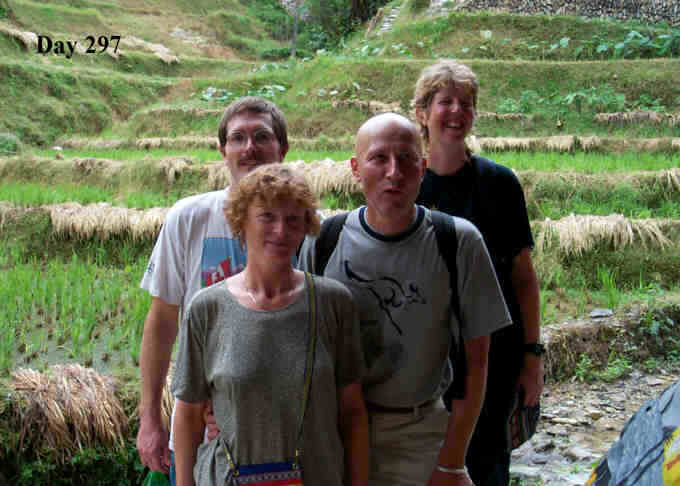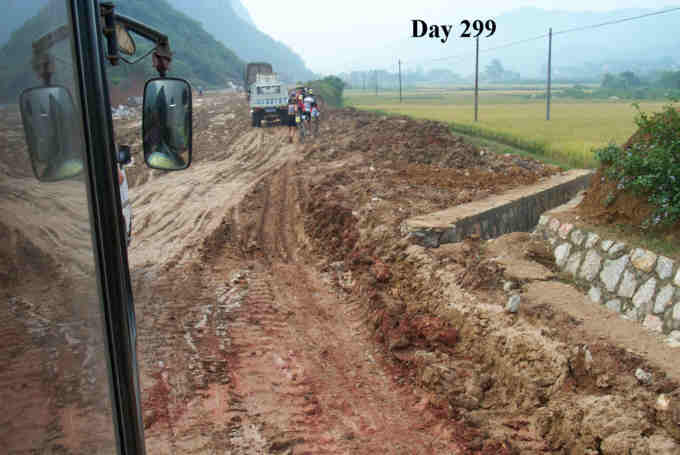

Page 92
Thailand ![]()
Malaysia 
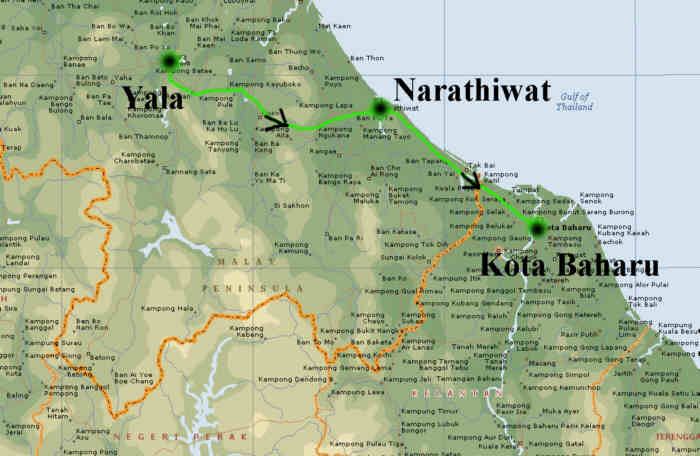
DAY
321
Yala to Narathiwat
November
16, 2000
Whatever our Yala Hotel lacked in plumbing, lights, and other comforts was more than compensated by the special after dinner program they had planned for us. The mayor was there to welcome us, and presented a special gift to TK&A. A group of school girls danced followed by traditional dancers in elaborate costumes. Then the Yala Mountain Bike Club representative spoke. I was very surprised to find that there was a mountain bike club there or anywhere in Thailand! After the program the members of the club swapped cycling jerseys with some of our riders. That was cool.
It had rained hard all night and it was still raining in the morning when we rode out of Yala. We thought we might be cold because it was very early morning, but we were fine. By ten when we reached Checkpoint it had stopped raining so at last out came our cameras. The Thai people have been very obliging about letting us take photos of them, even the Muslims which surprised me.
There were more good roads, more rice paddies and more rubber plantations. There were areas flooded by the recent rains so that rice paddies and rubber trees were flooded, also some homes and a school. The children who would have been in school were swimming in the flooded rubber plantation.
Just before reaching Narathiwat we stopped to see a golden Buddha, the largest sitting Buddha in Thailand. It looked so huge; I think someone said that it is 24 meters high.
Our hotel, The Royal Princess Narathiwat Hotel, was great. The rooms were nice and smelled fresh and the plumbing didn’t leak! Dinner was served in the extravagantly decorated ballroom and was followed by a speech by the governor. Dancers entertained and the local bicycle club came to visit which gave another opportunity for jersey swapping. The hotel had made an extraordinary effort to prepare for our visit. From somewhere they had borrowed a half dozen old and elegant bicycles, one reportedly belonging to the King in 1896. There were enormous bouquets of exotic flowers and peacock feathers. The dinner was the best we’d had in Thailand. It was a magnificent evening.
Goodbye, Alice
DAY
322
Narathiwat to Kota Baharu, Malaysia
November
17, 2000
Here we are in Malaysia! It was such a short ride, only 67 km. in all, that even with the long delay at Customs I had cycled to the hotel by noon.
After breakfast Joan found that her new rear tire had lost air overnight so she pumped it and we set off hoping it would hold. But it didn’t. By the time we reached Customs and the ferry it was soft again. She tried to pump it but it wouldn’t hold the pressure. Apparently the patched tube she had used was defective. She wasn’t feeling well anyway so she hopped into the sag wagon that was on the ferry with us.
The Takbai Border House had only one clerk at work. Perhaps it is usually not a busy border crossing but the more than 200 of us made it that way. We’ve had lots of practice this year at standing in long, slow lines but I still find it annoying. The little car ferry came and went and still I stood in line. I was very fortunate however to be among the first to arrive. I am sure latecomers must have been in line for hours.
On the Malaysian side a banner across the entrance welcomed Odyssey 2000 to Malaysia. We’ve had many welcomes but that was the first time a whole nation had welcomed us. All of Asia has been awesome in that regard. I shout ‘Hello’ and wave hundreds of times each day. It has been like one long parade! The people are so friendly and so tickled, thrilled really, when we speak to them that I make an effort to speak and wave to everyone. The children may giggle or shout with joy and adults often wish us well or give us the thumbs-up sign. This morning one beautiful young girl stepped forward and in careful English said, ‘Welcome to Malaysia’.
So far Malaysia looks much like Thailand, very green, very wet and there are lots of flowers and colorful bushes and plants. In China there just weren’t any flowers. No one had a decorative flower or plant in a pot or near the house anywhere. I decided that no space and energy could be wasted on the luxury of colorful and fragrant plants and flowers. There weren’t any wildflowers along the roads perhaps because all the vegetation was carefully trimmed or scraped away, which was not attractive and I don’t know why that was done. Vietnam was not a riot of color either, although flowers did begin to appear in the south. But in Thailand people filled their yards with flowers and potted plants by the dozens. There were hibiscus, frangipani, bougainvillea, bird of paradise, orchids and more that I don’t know. Many people also kept brightly colored birds and others for their beautiful songs. I have noticed that the Malaysians also are fond of birds and have several caged ones hanging near their homes.
In Malaysia at least some of the children have their own brightly colored child-sized bicycles. And already I have seen cell phones which were not in use in China, Vietnam and Thailand, at least not where we traveled which was admittedly, off the usual tourist route.
Malaysia is a Muslim country so we have seen mosques and heard the prayer call. There is an arrow in the hotel rooms indicating the direction of Mecca so that the faithful will know which way to face when praying. The women and young girls have their hair covered, most often with pastel colored scarves, only occasionally have I seen anyone in black which was the custom in Saudi Arabia.
Our hotel in Kota Baharu was the Renaissance Hotel, just opened in October. There is a magnificent crystal chandelier in the ballroom where we had an elegant buffet dinner. The tables were beautifully decorated with fresh bouquets and colorful linens. It seems like each day in Asia we get better and better hotels and food service. We have all thought and remarked that we are grateful to have begun our Asian cycling in China which I wouldn’t have missed for anything, but I would not enjoy going back to that level of service after our more recent experiences.
Goodbye, Alice
Today's Music
Negaraku - Malaysian National Anthem
Thailand ![]()
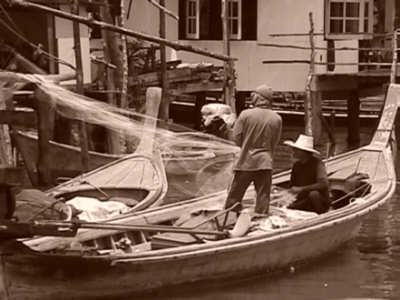
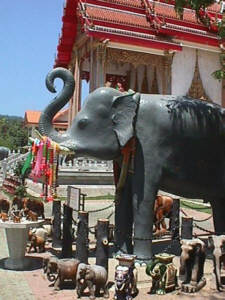
Malaysia 
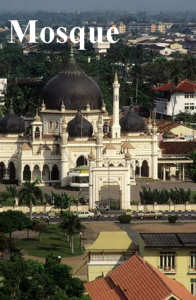
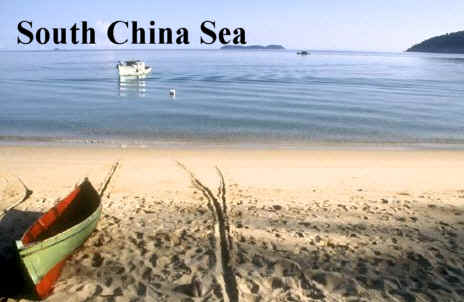
Mosque in Malaysia
The Masjid Zahir Mosque, completed in 1912, is in the center of Alur Setar, the capital of the Malaysian state of Kedah. Located near the country’s border with Thailand, Kedah is Malaysia’s most important rice-growing state. Some of the oldest settlements on the Malay Peninsula are here.Sea Dividing Malaysia
The South China Sea stretches for nearly 644 kilometers (nearly 400 miles) between Malaysia’s two land masses. The larger, eastern area of the country covers the northern quadrant of the island of Borneo, and the western half occupies the southern Malay Peninsula. This sandy beach is on the small island of Tioman, just off the peninsula’s southeast coast. Substantial underwater oil and natural gas reserves support Malaysia’s petroleum industry, which accounts for more than 25 percent of the country’s export earnings.
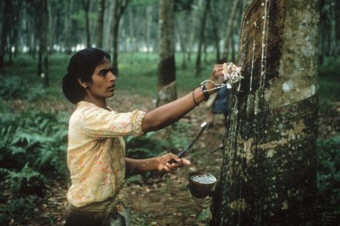
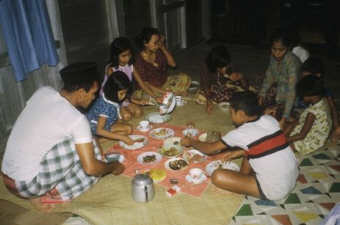
Precious Sap of Malaysian Rubber Trees
Though rubber trees first grew in Brazil, seedlings were brought to Malaysia from Great Britain in the late 1800s. Today, Malaysia is the world’s largest rubber producer. Early in the day, tree tappers cut V-shaped incisions into tree trunks and attach cups to the trees to catch the flowing latex. Hours later, the latex is collected and sent to a factory for processing.
Mealtime Customs
Malaysians traditionally eat their meals with their fingers while seated on floor mats. Fresh food is available year round, and fish and curries are popular. Rice is the Malaysian staple, however, and is eaten at least once a day and treated with great respect. Custom requires that a mealtime visitor be offered food. The guest must touch a bit of rice offered on a spoon or, according to superstition, risk being bitten by a snake or scorpion.
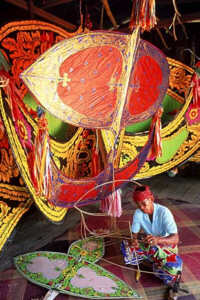
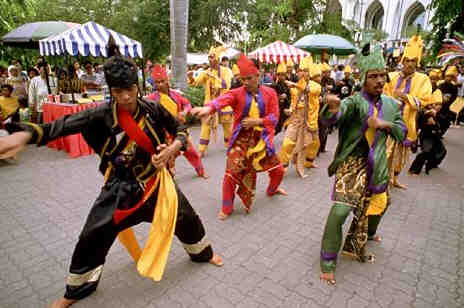
Kite Maker in Kota Baharu
In the coastal city of Kota Baharu, a master kite maker works at his colorful craft. Kite flying is a popular recreational activity in Malaysia. Traditional sports include sepaktakraw, a competitive team sport played with a rattan ball, and gasing, which involves spinning heavy tops for long periods of time.
Martial Arts Exhibition
The martial arts are traditionally important in Malaysia. Young Malay men are given instruction in pentjak silat, the art of self-defense, from an early age. Silat, like Japanese karate and Korean tae kwon do, involves a spiritual as well as physical dimension, emphasizing the practitioner’s inner power, cloaked by modesty and secrecy. Today silat demonstrations often take the form of stylized, dancelike exhibitions at weddings and other festivals. The grace and style of these demonstrations belie the effectiveness of the martial art in combat.
China ![]()
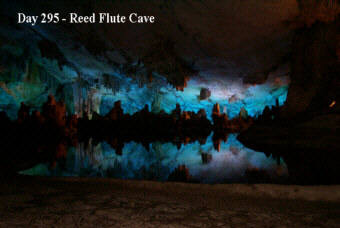
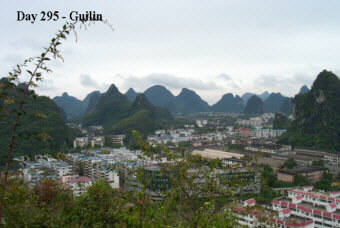
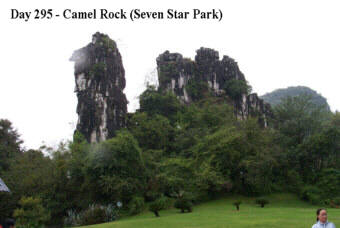
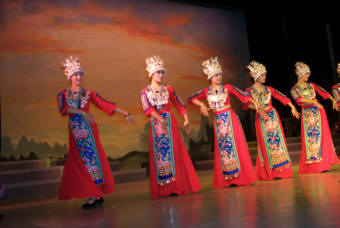
 Odyssey Riders and Staff
Odyssey Riders and Staff
